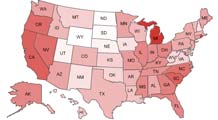Mortgage loans: Record number are late
Efforts to combat foreclosure plague are falling short as the total number of delinquent mortgage loans hits 9.64%.
| 30 yr fixed | 3.80% |
| 15 yr fixed | 3.20% |
| 5/1 ARM | 3.84% |
| 30 yr refi | 3.82% |
| 15 yr refi | 3.20% |
NEW YORK (CNNMoney.com) -- Mortgage borrowers are still falling behind on their payments in record numbers, despite the many foreclosure prevention efforts initiated by the government and non-profits.
In the third quarter, 9.64% of all mortgage loans were delinquent, according to a report released on Thursday by the Mortgage Bankers Association. That represents 4.5 million borrowers and is an increase from 9.24% in the prior three months.
"Despite the recession ending in mid-summer, the decline in mortgage performance continues," said Jay Brinkmann, MBA's chief economist. "Job losses continue to increase and drive up delinquencies and foreclosures because mortgages are paid with paychecks, not percentage point increases in GDP."
The delinquency rate includes all mortgage loans that are at least one payment past due but does not include loans in some stage of foreclosure.
The combined percentage of loans in foreclosure or at least one payment past due was 14.41% on a non-seasonally adjusted basis, the highest ever recorded in the MBA delinquency survey.
California, Florida, Arizona and Nevada continue to account for the lion's share of the foreclosure problem; the four represented 44% of all homes beginning the foreclosure process during the quarter.
One reason for the high rate is number of prime loans that went bad there. Many of these were option-ARMs, loans where borrowers had the choice of making minimum payments that did not even offset the interest being accumulated. For most option-ARM borrowers, mortgage balances grow rather than decrease.
At some point, usually when the accumulated debt reaches 10% to 25% more than the original principal, the loans get recast into fully amortizing, fixed rate mortgages. And when that happens, many borrowers simply cannot afford the new payments.
In California, 28.8% of all prime ARM loans were delinquent. Many of those were option ARMs.
Nationally, 26.6% of all prime ARMs were in foreclosure. That compared with 25.2% of all subprime ARMs and was the first time ever that a prime loan category performed worse than a subprime loan category, according to Brinkmann.
The market share of FHA loans, which are backed by the government, has grown exponentially over the past three years. As a result, the performance of these mortgages has come under scrutiny by politicians and others afraid that taxpayers are on the hook for big losses if the loans fail.
According to the report, delinquencies for all FHA loans stood at 14.36% at the end of September, with another 11.99% either in foreclosure or 90+ days past due. That is actually a slight improvement over the previous quarterly, when the delinquency rate was 14.42%.
Brinkmann contended that FHA loans should perform relatively well over the next few years. For one thing, the FHA terminated programs that allowed borrowers to obtain third-party down-payment assistance. A high percentage of FHA loans that defaulted in the past came through that program.
Secondly, so many FHA loans are of such recent vintage that the values of their collateral, the homes, has not decreased as much as the collateral value of many older loans.
"Many of these loans were issued at the bottom of the price cycle," said Brinkmann. "There will not be as many defaults based on a lack of home equity."
He added that FHA defaults have, historically, been linked closely to economic conditions. Many FHA borrowers are entry level and first-time homebuyers, ones just starting out in life.
These homeowners often have shorter work histories and may be more adversely affected by layoffs. But Brinkmann believes the worst of the layoffs are behind us, so the new FHA borrowers may not suffer as many layoffs as has occurred over the past two years.
As the economy recovers, delinquencies will fall, but Brinkmann said it will take longer than the usual six months lag between an up-tick in hiring and a down-tick in delinquencies.
"With the big decrease in home prices, I see a lengthening of the process," he said. "Delinquencies will stay persistently higher than we've seen with most recoveries."
It could be a year or more after the unemployment rate stats to drop that the delinquency rate starts to improve. That may not be until at least mid 2011. ![]()





